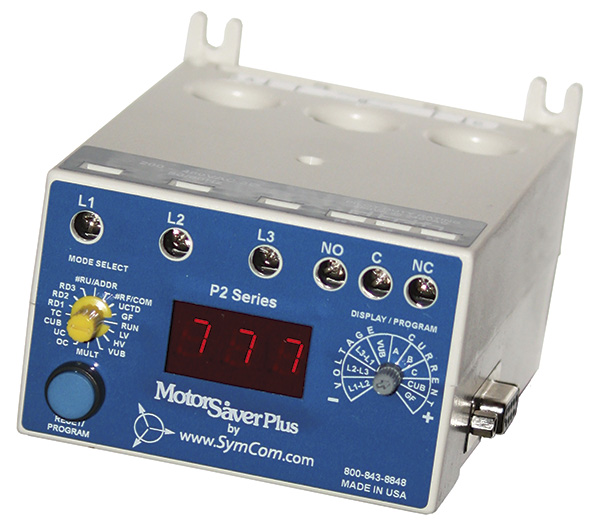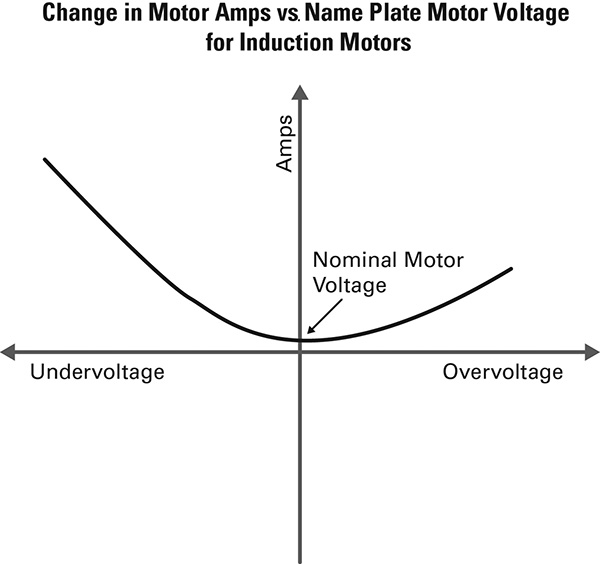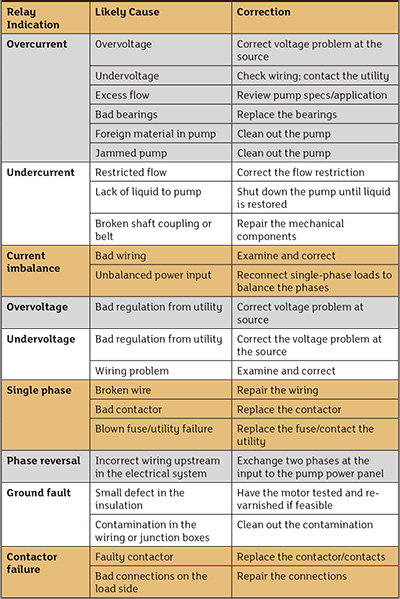Electronic motor protection relays are available for general-purpose applications. They protect against problems such as overcurrent, phase loss and voltage unbalance. However, some problems that are unique to pumps make considering a protective relay designed specifically for pumping applications worthwhile (see Image 1). These units have different designations—pump protection relays, electronic overload relays, electronic motor protective relays and others—but in general, they tend to have certain characteristics in common. One way that units suitable for pump protection differ from general motor protection relays is their ability to sense underload conditions. This article explores the functions of electronic pump protection relays and provides some pointers on how they are best applied.
 Image 1. A pump protection relay provides valuable information about motor conditions. (Images and graphics courtesy of Littelfuse, Inc.)
Image 1. A pump protection relay provides valuable information about motor conditions. (Images and graphics courtesy of Littelfuse, Inc.)Overcurrent & Undercurrent
Over time, excess current passing through a motor causes overheating and can dramatically shorten the motor’s life. Small overcurrents just above the rated current—by 5 or 10 percent, for example—will slowly overheat the windings and damage the insulation. While all motors must be protected by internal/external thermal overloads (bimetallic or eutectic), these may not operate until the motor is dangerously hot. Early detection of an overcurrent allows users to investigate the cause and take any necessary corrective measures before equipment is damaged. These older style overloads, however, may also allow the motor to be restarted before it has time to cool to a safe temperature. Overcurrent in a pump motor has several potential causes. Overvoltage and undervoltage can both lead to overcurrent, but mechanical problems are more common (see Figure 1, page 32). A binding shaft or bad bearings can directly increase the load on the motor and should be corrected immediately. On a wastewater lift station pump, a rag or other debris caught in the impeller can cause excessive drag and increased current, or it can reduce flow and cause an undercurrent. Debris caught in the pump can cause a jam or locked rotor, which requires an immediate shutdown to prevent motor damage. Because the power consumed by a centrifugal pump is an almost linear function of flow, anything that reduces the flow will reduce motor power consumption. A loss of flow or undercurrent condition can damage the pump or motor if the fluid is used for cooling. This condition is true regardless of whether the restriction is on the intake or discharge side of the pump. Two measurements can help end users detect an underload: current and power. Equipment operating normally with a power factor (PF) greater than 0.7 will show a dramatic change in current if unloaded. When equipment is designed to operate normally lightly loaded—with a PF less than 0.4—the loss of load does not change the current significantly, but modern relays have enough resolution to see this change by measuring the power (the phase angle combined with the current). This type of monitoring is more complex but more accurate for lightly loaded devices such as magnetically coupled pumps that need flow loss detection. The appropriate response to an underload depends on the circumstances. For example, a lift station pump takes in a rag, causing a small overload or underload. Setting the protective relay to shut down for several minutes and making one restart attempt may be a good decision. This will allow the debris an opportunity to free itself. If the problem persists, then the relay should shut off the motor, alarm and require manual intervention. For some submersible well pumping applications, the well may run dry temporarily from time to time. In this case, the pump should be shut down, and the relay should delay a restart for a longer period of time to give the well time to refill so that normal operation can resume. If the mechanical coupling between a motor and pump fails, the result will be a free-spinning motor and a stopped pump. While this may not damage the motor, it wastes electricity without producing any work and should be detected and corrected as soon as possible. Figure 1. An increase in motor amperes may indicate either an undervoltage or an overvoltage condition.
Figure 1. An increase in motor amperes may indicate either an undervoltage or an overvoltage condition.Overvoltage & Undervoltage
Overvoltage will increase the current and result in increased motor heating and shorted life. If the power utility increases its line voltage to compensate for the increased load, when the load decreases, the voltage to the motor can become excessive. Similarly, if the power utility allows the voltage to sag under heavy loads, the motor can suffer from a low-voltage condition, which will also cause it to draw more current (see Figure 1).Three-Phase Voltage or Current Imbalance
Three-phase motors are designed to have balanced power, so all three motor windings share the load equally. If one phase of the supply is significantly higher or lower than the others, the result will be excessive current in one or more of the motor windings, which can lead to overheating, insulation degradation and shortened motor life. Phase imbalance can be caused by the presence of single-phase loads that are not evenly distributed among the utility’s phases. Air conditioners can be prime offenders, although many other applications, such as air compressors and arc welders, also experience this issue. The urgency of the situation depends on the amount of imbalance. Pump protection relays can be set to ignore small unbalances and alert or shut down larger ones. The appropriate setting for the relay depends on how much imbalance the motor can tolerate and how often an unbalanced condition occurs. While the utility may install a set of autotransformers to correct phase imbalance caused by single-phase loads, these solutions tend to be expensive. Often, the single-phase loads can be better distributed across the three phases, but detecting the problem is an important part of the solution.Missing Phase
If the voltage imbalance on a three-phase system becomes severe, a single-phase condition results on the motor, which will quickly overheat, and the pump must be shut down until the problem is fixed. A loss of one phase at the motor, but no failure of the incoming electrical system, is also possible and may occur because of a failed contact on a contactor, a loose or corroded connection, or a damaged wire between the switchgear and motor. Some protective relays can detect, protect and identify this problem. Table 1. The likely causes of relay indications and possible corrections. Click here to view a larger version of this table.
Table 1. The likely causes of relay indications and possible corrections. Click here to view a larger version of this table.
